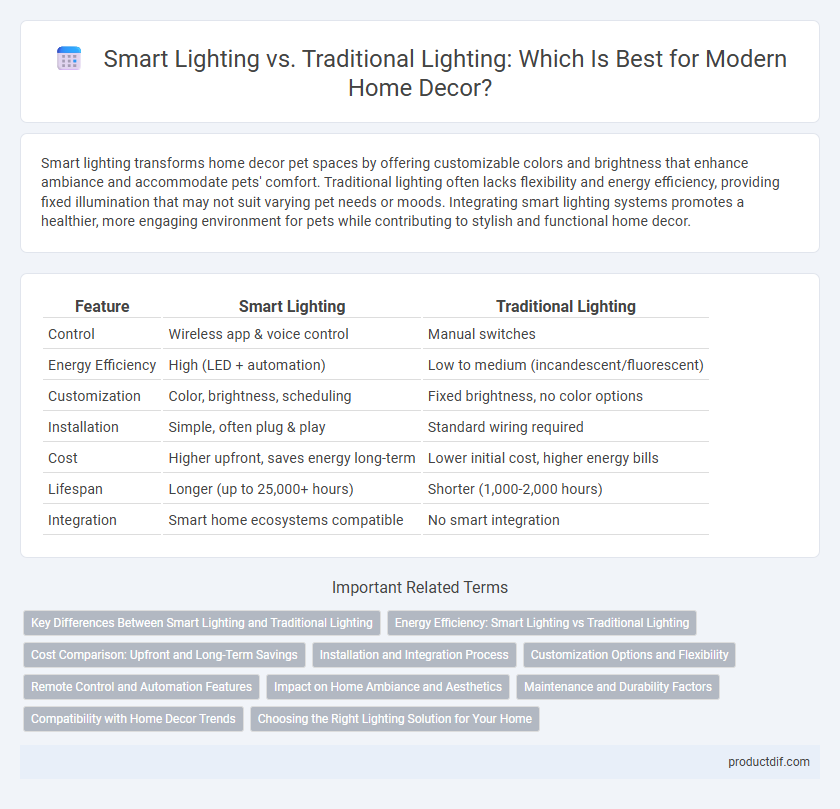Smart lighting transforms home decor pet spaces by offering customizable colors and brightness that enhance ambiance and accommodate pets' comfort. Traditional lighting often lacks flexibility and energy efficiency, providing fixed illumination that may not suit varying pet needs or moods. Integrating smart lighting systems promotes a healthier, more engaging environment for pets while contributing to stylish and functional home decor.
Table of Comparison
| Feature | Smart Lighting | Traditional Lighting |
|---|---|---|
| Control | Wireless app & voice control | Manual switches |
| Energy Efficiency | High (LED + automation) | Low to medium (incandescent/fluorescent) |
| Customization | Color, brightness, scheduling | Fixed brightness, no color options |
| Installation | Simple, often plug & play | Standard wiring required |
| Cost | Higher upfront, saves energy long-term | Lower initial cost, higher energy bills |
| Lifespan | Longer (up to 25,000+ hours) | Shorter (1,000-2,000 hours) |
| Integration | Smart home ecosystems compatible | No smart integration |
Key Differences Between Smart Lighting and Traditional Lighting
Smart lighting systems utilize LED technology with remote control and automation features, enabling energy efficiency, customizable ambiance, and integration with smart home devices. Traditional lighting typically relies on incandescent or fluorescent bulbs controlled by manual switches, lacking automation and advanced energy-saving capabilities. Smart lighting offers enhanced convenience and adaptability for modern home decor, while traditional lighting provides simplicity and straightforward operation.
Energy Efficiency: Smart Lighting vs Traditional Lighting
Smart lighting systems leverage advanced LED technology and adaptive controls to optimize energy consumption, significantly reducing electricity usage compared to traditional incandescent and fluorescent bulbs. Sensors and automated scheduling enable smart lights to operate only when needed, enhancing energy efficiency by up to 80% over conventional lighting solutions. Traditional lighting often lacks such control mechanisms, resulting in higher energy waste and increased utility costs in home decor settings.
Cost Comparison: Upfront and Long-Term Savings
Smart lighting systems typically have higher upfront costs than traditional lighting, with prices influenced by advanced features such as app control, automation, and energy-efficient LED technology. Over time, smart lighting offers significant long-term savings through reduced energy consumption, longer bulb lifespan, and customizable settings that lower electricity bills. In contrast, traditional lighting may require more frequent replacements and consumes more energy, resulting in higher cumulative costs despite the lower initial investment.
Installation and Integration Process
Smart lighting systems offer streamlined installation with wireless controls that easily integrate into existing home automation platforms, reducing the need for extensive rewiring. Traditional lighting requires more complex electrical work, including manual switch installation and often additional wiring to accommodate dimmers or timers. Integration of smart lighting enhances energy efficiency and user convenience through app-based controls and voice assistant compatibility, unlike traditional fixtures.
Customization Options and Flexibility
Smart lighting offers extensive customization options, including adjustable brightness, color temperature, and programmable scenes that adapt to different moods and activities. Traditional lighting typically provides limited flexibility, constrained to fixed brightness levels and static color temperatures. Integration with smart home systems allows smart lighting to respond dynamically to voice commands and schedules, enhancing convenience and personalized ambiance.
Remote Control and Automation Features
Smart lighting systems offer advanced remote control capabilities through smartphone apps and voice assistants, enabling users to adjust brightness, color, and schedules from anywhere. Traditional lighting lacks these automation features, requiring manual operation via switches or dimmers. The integration of automation in smart lighting enhances energy efficiency and convenience, transforming home ambiance with programmable settings tailored to daily routines.
Impact on Home Ambiance and Aesthetics
Smart lighting transforms home ambiance by offering customizable color temperatures and brightness levels that adapt to different moods and activities, enhancing aesthetic appeal with dynamic, programmable effects. Traditional lighting, limited to fixed brightness and color, often falls short in creating versatile atmospheres, resulting in more static and predictable home environments. The integration of smart lighting systems elevates interior design by providing seamless control through apps and voice commands, optimizing both function and style.
Maintenance and Durability Factors
Smart lighting systems offer lower maintenance requirements due to their energy-efficient LED components and longer lifespan, often exceeding 25,000 hours compared to traditional incandescent bulbs that last around 1,000 hours. Traditional lighting, while easier to replace and repair, tends to consume more energy and requires frequent bulb changes, increasing overall maintenance costs and effort. Durability in smart lighting is enhanced by integrated technology such as remote control and automated scheduling, reducing wear and tear from manual use.
Compatibility with Home Decor Trends
Smart lighting offers seamless integration with modern home decor trends through customizable colors and adaptive brightness that complement minimalist, industrial, and Scandinavian styles. Traditional lighting fixtures often prioritize classic designs but may lack the flexibility to match evolving aesthetic preferences or dynamic ambiance settings. Emphasizing compatibility, smart lighting systems support trend-conscious homeowners seeking both functionality and style in their living spaces.
Choosing the Right Lighting Solution for Your Home
Smart lighting offers customizable brightness levels, color temperatures, and automation features that enhance energy efficiency and convenience compared to traditional lighting. Traditional lighting solutions typically provide consistent illumination with simpler installation and lower upfront costs, suited for basic lighting needs. Selecting the right lighting solution depends on your home's functional requirements, design preferences, and budget considerations to achieve optimal ambiance and utility.
Smart Lighting vs Traditional Lighting Infographic

 productdif.com
productdif.com